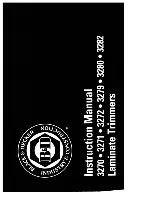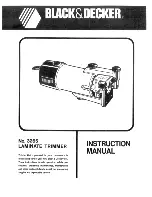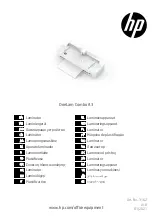
GBC 4064WF
Operation Manual
© 2005 General Binding Corporation
Page 24
SPEED / TEMPERATURE CONTROL
This is only a general reference guide. Different settings may be suitable as the warm up time, lamination time and materials change.
Factors that may affect the speed and temperature parameters;
1.
Image length thickness
2.
Image width and ink coverage
3.
Ink coverage
4.
Paper type
5.
Laminate thickness
6.
Operating environment
7.
Condition of the rollers
8.
Line voltage (effects heaters)
9.
Using cooling features.
You may have to adjust temperature or speed depending on stock finish, *Turn heat off when not in use.
NIP ROLLERS SHIM DIAL Adjustment
The Nip Setting dail has the following choices.
“LAM”, 0”, 1/16
th
”, 1/8
th
”, 3 /16
th
“, 1/4
th
”, 3/8
th
”, 1/2
th
”, 3/4
th
” & 1”
The “LAM” Setting is used in applications where full pressure is desired. The “LAM” is used for some applications like Pressure sensitive or
encapsulation where thick material is being laminated and better edge seal is needed.
The “0” setting is used in most general encapsulation applications, especially when laminating wide thin materials.
The “0” setting provides a positive stop on the downward pressure regardless of the Pneumatic downward pressure. The positive Stop helps to
create the most consistent even Nip foot print across the roll.
The “O” setting is adjusted and set with the Main rolls cold, a small amount of light is visible between the rolls about 5” in from each end.
THE ART OF LAMINATION
BASIC RULES
•
Do not attempt to laminate abrasive or metal Objects such as staples, paper clips and glitter, as they may damage the heat or pull rollers.
•
Do not force items into the nip area of the heat rollers. An item that is not easily drawn into the laminator by the heat rollers is probably
too thick to laminate.
•
Wrinkles may result if an attempt is made to reposition an item once it has been grasped by the heat rollers.
•
Do not stop the laminator before an item has completely exited the pull rollers. Even a momentary stop will cause a mark (heat line) on
the laminated item.
Good, consistent lamination is a result of combining proper heat, tension and dwell time. Dwell time is controlled by the speed of the motor and is
defined as the amount of time the material to be laminated is compressed between the heat rollers.
As a general rule, thicker items and film need to run at slower speeds because they extract more heat from the rollers at a quicker rate. Setting the
speed control at slower settings gives the laminator longer dwell time thus allowing proper lamination of thick items. Thinner items, such as
standard copier paper (20 lb. bond) and tissue paper, extract less heat from the rollers and can be run at faster speeds.
FILM TENSION
Proper film tension, known as brake tension, is the minimum amount required to eliminate wrinkles in the finished item. The film should be taut. A
properly adjusted roll of film should not require excessive force to turn by hand.
Film tension should be enough to introduce a minor amount of drag as the film unrolls. Insufficient tension causes wrinkles, while too much
tension causes stretching (necking). Uneven tension between the top and bottom rolls creates curl. Too much upper tension creates upward curl
while too much bottom tension causes downward curl.
Adjustment of the pull roller clutch may be necessary if after adjusting unwind and rewind brake tensions do not improve your output quality.
EDNord - Istedgade 37A - 9000 Aalborg - telefon 96333500



































